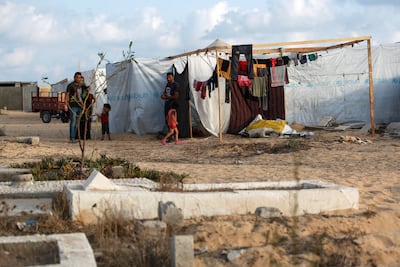Live updates: Follow the latest on Israel-Gaza
Where is safe for civilians in Gaza? It is a question that had been raised repeatedly by conflict monitors and the UN since Israel launched its military offensive against Hamas and other militant groups in the densely populated Palestinian territory.
Nearly 10 months later and after more than 39,000 Palestinian deaths, most of them civilian, it increasingly appears that the answer might be “nowhere”, despite the military's repeated designation of “humanitarian corridors” and “safe zones”.
Experts say the Israeli military's measures, although in keeping with the principles of international humanitarian law that seeks to minimise the destruction and suffering caused by armed conflict, are not enough and that their implementation often has the opposite effect.
Often, civilians are given little time to act on the military's orders to leave their homes and shelters ahead of impending attacks, and these orders come with only rudimentary maps showing the evacuation areas, escape routes and safe zones.
“Evacuation orders, according to the international military law, have certain criteria,” Hisham Mhanna, spokesman for the International Committee of the Red Cross (ICRC), told The National.
“First, they have to reach people in a timely manner. They have to be clear in a sense that people can receive them in time and understand them. There has to be clear, safe pathways given to the people, with clear timing.”
An evacuation order issued to civilians in eastern areas of Khan Younis and Rafah earlier this month came 20 hours after hostilities began, Mr Mhanna said.
“They were simply given or shared in the Arabic version for people to move towards the humanitarian zone. There was no clear pathway or timing for them.”
The ICRC is one of the primary co-ordinators between the warring sides in conflict zones, often giving key actors like doctors and other civilians the green light to move from place to place without getting shot. This role is known as providing “notification arrangements”.
After getting their consent, the ICRC shares civilian locations with the Israeli forces, so that the army is aware of their presence before carrying out any military operations.
But Israeli forces have been known to scramble telecommunication signals before carrying out major operations in certain areas, causing communication blackouts and confusion.

“That also contributes to the success or failure of having people reach safety. Of course, there is no safe space in Gaza with a 100 per cent guarantee,” Mr Mhanna said.
Aside from forcing people to make heartbreaking, last-minute decisions about leaving home, the evacuation orders have often led to civilians fleeing into areas of fighting and bombing, leading to further loss of life.
“For many of them, it's a life or death decision to move or to stay,” Mr Mhanna said.
“And, as a reminder: civilians are protected all the time [under international humanitarian law]. Even if they chose to voluntarily stay where they are, their homes, they remain protected,” he pointed out
Even the supposed safe zones have been subjected to attacks by the military, which often cites the presence of militants in the area.
former executive director of Human Rights Watch
One recent attack in a “humanitarian zone” in southern Gaza prompted international condemnation after scores of people were killed and hundreds injured.
According to American rights activist and lawyer Kenneth Roth, a former executive director of Human Rights Watch, Israel used “eight, huge, 2,000lb bombs” in the June 13 attack on Al Mawasi, where Israel has repeatedly told civilians to go before launching offensives in Khan Younis and Rafah.
With such bombs capable of killing people within a 200-metre radius, the high toll from the attack was not surprising, Mr Roth said.
“That was not a serious effort to take all feasible precautions to spare civilians, as international humanitarian law requires, especially because Israel had deemed it a safe area and then ignored that designation and bombed it,” he told The National.
Israel said the target of its attack was Hamas commander Mohammed Deif, considered one of the masterminds of the group's deadly October 7 attack on southern Israel that triggered the war. It has not confirmed whether he was killed.
Both Mr Roth and Mr Mhanna said Gaza would not have experienced the current scale of death and suffering if international humanitarian law had been observed.
“International humanitarian law is plenty strong,” Mr Roth said. “It does not need to be changed. It needs to be enforced. That requires prosecution of offenders but it also requires political pressure.”





